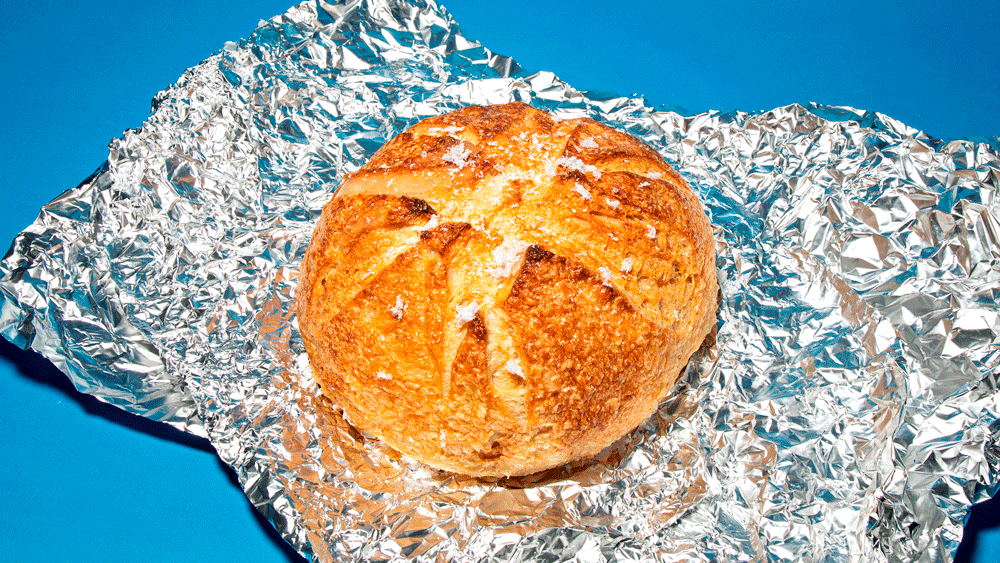
Frozen or stale, those forlorn baguettes and leftover sourdough slices are not a lost cause.
The story is always the same. You buy an enormous hunk of einkorn wheat bread at the hip local bakery but only eat half of it at dinner. Maybe you toast a slice or two the next morning for breakfast, but the grim countdown to stale has already begun. So you pop the rest of the loaf in the freezer—of course you’ll get back to it soon. Next thing you know, your freezer is full of half-finished, vaguely freezer-burned loaves behind the frozen peas and fancy ice cube trays. How to bring these rock-solid loaves, sitting there with such frosted-over promise, back to life? It’s a tale as old as bread, and thankfully, a long list of enterprising bakers and resourceful home cooks have been working on solutions for centuries, with help from refrigerators, spray bottles, and running water faucets.
Zoë Kanan, baker and pastry chef at New York’s Simon & the Whale, relies on nothing more than an oven. She simply throws the frozen bread in at 375°F until it’s warmed all the way through. “The icy interior melts and steams through the crumb, keeping it nice and soft while reviving the crispness of the crust,” she says. It may seem too simple to be true, but Kanan feels anything more is superfluous. “I place the loaves directly on the oven rack, unwrapped,” she adds. Meanwhile, cookbook author and food stylist Erin Jeanne McDowell swears by thawing the frozen bread overnight in the refrigerator, within a tight wrapping of aluminum foil. “The moisture from thawing reinvigorates the bread, and the foil helps keep it inside,” she says.
But if the bread you’re defrosting is already a little bit stale, it might need some extra help on the moisture front. Tara Jensen, cookbook author and founder of Smoke Signals, a project dedicated to teaching the craft of sourdough bread-making, uses a method on the defrosted bread that seems almost too wacky to work (but it does, it really does!). “Run it under lukewarm water, wring it out, and pop it in the oven, directly on the grate or on a sheet pan, at 200°F for 15 minutes to refresh,” Jensen says, explaining that while you don’t have to, wrapping the soaked bread in foil will yield the best result. “This will rehydrate the starches and bring the loaf back to life almost miraculously. However, this can only be done once, and the bread should be used right away.”
Emily Schostack, who works in education and events for Eataly, uses a similar tactic that she picked up while working at a bakery, in an effort to avoid wasting loaves of unsold bread. Schostack keeps a spray bottle of water handy in her kitchen, and when she needs to revive leftover or frozen bread, she just gives it a spritz and bakes it for 10 minutes at 375°F.
Though no one likes to waste bread, most of these bakers agree that any frozen bread pulled out of the freezer is less than ideal. “I like to joke that bread, although precious, is not an heirloom quilt and should be eaten as fresh as possible, generally within three days of baking,” says Jensen, recommending that loaves should be stored in a paper bag inside of a canvas or linen bag—on the counter, not the fridge. “The paper will absorb moisture, and the cloth will let it breathe so there’s no danger of molding.” However, she knows better than most that sometimes there’s simply too much bread to be eaten all at once.
To prepare the bread for the freezer, Jensen actually recommends slicing the loaf while it’s fresh before freezing the slices in a gallon Ziploc bag (or two, if you’re worried about freezer burn). Though the whole-loaf-dunked-in-water method won’t work with sliced bread, Jensen has another trick up her sleeve. “When you’re ready to refresh the bread, pull it out slice by slice, and reheat it in a cast iron skillet or on a warm griddle greased with butter,” Jensen says. By heating the relatively thin slices, even if frozen, gently in the pan, “this method ensures the edges stay crispy, while the center stays tender and moist.”
For some loaves, it won’t matter how long you dunk them in water. If the bread’s exterior is stale enough that you could, say, use it as a small step stool, its destiny is not for building your sandwich. Before you mourn the loaf’s premature death and head for the compost bin, there’s another option. Just tear the bread into bite-size pieces, toss with olive oil and salt, and pan-fry until golden brown—and presto, you have croutons. It’s never too late to bring bread back from the brink.